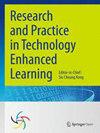Mathematics student personas for the design of technology-enhanced learning environments
IF 3
Q1 EDUCATION & EDUCATIONAL RESEARCH
Research and Practice in Technology Enhanced Learning
Pub Date : 2023-01-02
DOI:10.58459/rptel.2023.18032
引用次数: 2
Abstract
To benefit from the quickly expanding range of new possibilities of technology-enhanced education, school systems, schools, and teachers need to adapt quickly. Conversely, the needs of students and teachers in a technology-enhanced classroom require technology developers to provide and improve suitable technologies. In this paper, we aim to show how to make the professional knowledge of mathematics teachers accessible to developers of technologies and also to teacher trainers and trainees by the use of student personas, i.e., portraits of archetypical students with particular characteristics and needs. We have collected qualitative data from pre-service and in-service mathematics teachers in Austrian academic upper secondary schools about the characteristics and needs of their students. We have analysed these data using a grounded theory approach to derive demands of students on technology-enhanced learning environments (TELEs). We have identified and presented five personas, each with specific demands on TELEs, to represent this target group. By introducing this approach that combines techniques from mathematics education research and from user experience research, we are able to represent user groups of a mathematics technology-enhanced learning environment in a more relatable way than was previously possible. These relatable representations of students in Austrian academic upper secondary schools could be of particular importance for developers of technology-enhanced learning environments for teaching and learning mathematics. The methodology presented in this paper is adaptable to other contexts.数学学生角色的技术增强学习环境的设计
为了从技术增强教育迅速扩大的新可能性中受益,学校系统、学校和教师需要迅速适应。相反,在技术增强的课堂中,学生和教师的需求要求技术开发人员提供和改进合适的技术。在本文中,我们的目的是展示如何通过使用学生角色,即具有特定特征和需求的典型学生的肖像,使技术开发人员以及教师培训者和学员能够访问数学教师的专业知识。我们从奥地利学术高中的职前和在职数学教师中收集了关于学生特征和需求的定性数据。我们使用扎根理论方法分析了这些数据,以得出学生对技术增强学习环境(TELEs)的需求。我们已经确定并提出了五个角色,每个角色对TELEs都有特定的要求,以代表这一目标群体。通过引入这种结合了数学教育研究和用户体验研究技术的方法,我们能够以比以前更相关的方式表示数学技术增强的学习环境的用户组。奥地利学术高中学生的这些相关表现对于技术增强的教学和学习数学环境的开发人员来说尤其重要。本文提出的方法适用于其他情况。
本文章由计算机程序翻译,如有差异,请以英文原文为准。
求助全文
约1分钟内获得全文
求助全文
来源期刊

Research and Practice in Technology Enhanced Learning
Social Sciences-Education
CiteScore
7.10
自引率
3.10%
发文量
28
审稿时长
13 weeks
 求助内容:
求助内容: 应助结果提醒方式:
应助结果提醒方式:


